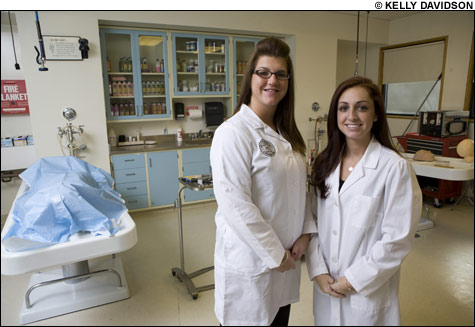
BEAUTY SLEEP: Our job is to help the families, and to “make the deceased look the best we can,” says mortuary student Megan Peterson |
Like any other 20 year olds, Megan Peterson and Mackenzie Byles chatter like hyperactive squirrels, excitedly finishing each others' sentences as though they're alien twins with melded minds. The young women, juniors at Mount Ida College in Newton, are bright, well-spoken, and trendy, perfectly French-manicured and perfectly flat-ironed. Peterson sports black hipster glasses with tiny rhinestone butterflies on the rims. Byles resembles a healthy Lindsay Lohan with spindly eyelashes.It's incongruous to imagine their manicured hands expertly slitting a corpse's neck, fishing around under flesh and sinew with sinister-looking hooks for the carotid artery, exposed muscle tissue looking as plump and juicy as pre-packaged raw chicken breasts.
These fresh faces are the future of funeral service.
As President Obama tries to resuscitate a flat-lining economy left for dead, a new wave of young females like Peterson and Byles are breathing life into the business of death. With increasing fervor, women are permeating what was once a male-dominated industry. According to a study conducted by the National Funeral Directors Association, women now make up approximately 60 percent of the country's mortuary-college enrollment; the average mortuary student is a female who falls between the ages of 18 and 24, and does not have family ties to the estimated $11 billion industry.
Both Peterson (of Quincy) and Byles (of Groton, Connecticut) are studying funeral-home management and bereavement at the New England Institute (NEI), one of the area's two mortuary colleges and an academic subset of Mount Ida. Here, students learn every aspect of the industry: technical skills, such as restorative art and embalming (the odors churned up by an embalming "kind of depends on the person," notes Peterson. "Once you start, you can smell faint formaldehyde and cavity fluid, but that's really it."); scientific fields of study, such as anatomy and microbiology; and the "human" side of mortuary science (bereavement counseling, marketing, and funeral-home management).
Yes, the funeral business is multi-faceted, and in many ways like a regular business — albeit one in which corpses play a critical role. But its stigma still makes the choice for women to go into this field a difficult one.
"I'll never forget what happened to me at freshman orientation," says Byles. "I was in a crowd of students and a girl asked what my major was. I told her, and she made this terrible face at me and then just walked away, as if I was so bizarre and weird. Dead bodies don't gross me out, but I'm not obsessed with the dead. People assume that I should be weird and goth. Or that I should be in fashion or something. Because I'm a girl, I guess?"
"Everyone looks at us like, 'Really?' " says Peterson, scrunching up her face in imitation of a skeptical classmate. "Usually people don't remember my name — just my major. I think it's because there's a lack of information out there as to what [funeral directors] actually do. We interact with families, help them, give them advice. We try to make the deceased look the best we can."